We’ve Got This Bridge Covered
Comstock Bridge, East Hampton/Colchester
April 1, 2007
2018: It has been a long, long time since I’ve revisited this page. Or the bridge. So my pictures are too small. But… you’ll survive.
Connecticut has three remaining historic covered bridges and I’ve already been to the two out in the northwest hills during prior travels. They are both drivable and functional. The Comstock Bridge, however, is not. It spans a small river in a tiny little park which is no more than the bridge, a parking lot, the River, and maybe 50 feet of river bank without much of anything to do.
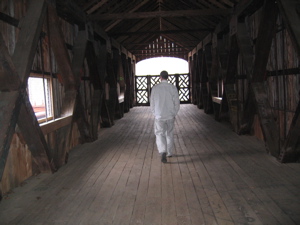
So there I was, staring at an unused bridge in semi-rural Connecticut with my wife, son, and friend, Becky – not sure what our next move was. We had just come from the nearby Chatham Historical Society Museum and were eager for some more CTMQ action. It was rather brisk and gray and, well… there really isn’t a whole heck of a lot to do.
I’d recommend a picnic down on the river bank in warmer weather maybe, and the family who was fishing seemed to be enjoying themselves for the most part. Truth be told, so were we. The Comstock is a rather handsome bridge – Becky even knows a now-married couple that got engaged at this very spot – not quite the Steve/Hoang story on top of Mount Royal overlooking Montreal, but hey, whatever works, right? We walked up to the bridge and soaked in the scenery. Nice.
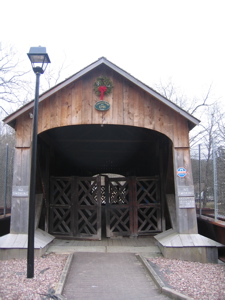
With Hoang and Becky yapping it up, I searched in vain for a historical marker of some sort… Who was Comstock? Why has this bridge survived and most others in Connecticut haven’t? Why was it closed to traffic? And hey, why are covered bridges covered anyway?
So many questions, so few answers. But that’s what the Internet is for, so let’s see what we can find.
The Chatham Historical Society site eloquently says, “Built in 1791 and named by General Comstock, the bridge spans the Salmon River and connects East Hampton to Colchester.” Fair enough… though 20 minutes of Googling “General Comstock” and then variations on the theme came up dry. I’m sorry to say that the mystery of who/which General Comstock the bridge was named after will remain a mystery*.
*See update at bottom.
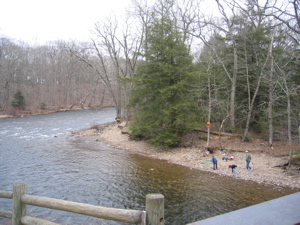
I would like to point out, however, that I found some fascinating reading on a Civil War veteran named Captain C.B. Comstock (Union) who headed up the Army Balloon Corps at one point. I’ll admit it, I had no idea that there was such a thing during the Civil (or any) war. He was from the Army Corps of Engineers so it would make sense he’s the Comstock in question, but he was only a Captain and from New York… so that doesn’t really add up.
We made our way across the span and noted that the interior was scarred with years of graffiti. Apparently it was much, much worse 15 or so years ago when local groups petitioned the Federal government for some money to save it. In researching that project, I learned more than I ever thought I wanted to know about this particular covered bridge:
This is one of the three remaining covered bridges in Connecticut. Of the three, it is the only one still carrying its own weight with the original timber superstructure. The main span is a 90 ft. long Howe truss built in approximately 1840. It is one of the oldest, if not the oldest, remaining original Howe truss in existence. The truss and floorbeams date from the original time of construction, including the original iron rods. The approach span is a 36 ft. long Queen post pony truss constructed in 1791. The bridge carries pedestrian traffic in a state park setting, and will continue to be a pedestrian bridge after preservation/rehabilitation work. In 1974, major rehabilitation was conducted which included removal of a 12″ negative camber, and strengthening of the bridge. The State notes that the negative camber is returning, the truss is getting out of plumb in opposite directions at each end, and the wood has biological deterioration, although the extent is unknown. The State Historic Preservation Officer (SHPO) has certified that preservation of the bridge is warranted in accordance with SHPO’s Statewide historic preservation plan.
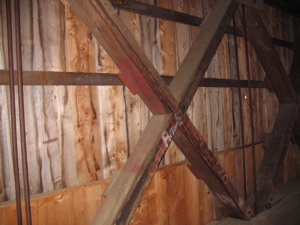
And, as you all know, a negative camber is the death knell of all covered bridges. So they requested $482,800 and received $84,800 according to the Federal Highway Administration. If only they had a modern 21st century appropriations bill to tack it onto, the somewhat barren park would probably have a monorail and glass bottomed boat service. Instead, with their relatively limited funds, the locals did what they could and now that we were across the bridge and gazing back at it, I think they did a lovely job. And since you are now saying, “What exactly did they do?” I’ll let the East Hampton Town website tell you:
In the early 1990’s, there was growing concern over the problem of vandalism at the bridge and the need for extensive renovations. A group of representatives from East Hampton’s civic groups, called C.A.R.E. (Chatham Alliance of Resources) agreed to have lights installed to deter vandalism, make renovations to the bridge, and make exterior improvements to create a park for all to enjoy. For one year this group worked with the Department of Environmental Protection, Department of Transportation, the Connecticut Historical Society and Governor William O’Neill to make all the necessary improvements to the area. On May 19, 1996 the Comstock Bridge was rededicated at a very special ceremony. A new plaque was put on the front of the bridge, shrubs and flowers were planted, a new fence was built and a parking lot was laid, and the bridge was reinforced with wood chosen to match the existing planks.
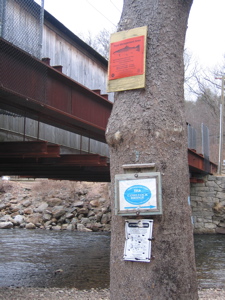
Now across the bridge and approaching private lots, we turned towards the river and went to check out what was there. There were several signs noting the rules and regulations surrounding trout fishing in the river. I also noted that a blue-blaze trail passes through; something called the Salmon River Trail.
Trout fishing season didn’t open for a few more weeks and I knew when that happens, this bucolic little park would be a madhouse. So with that in mind, we slowly crossed back over the bridge, took one last look, and headed home. On the way, Hoang and I were reminded why we chose not to live in these parts… Hunting defenseless deer sounds boring enough to us, but this? This is just ridiculous:
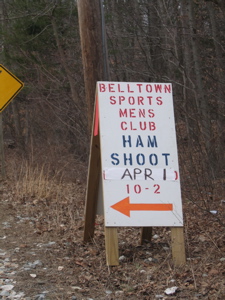
Oh wait, there’s a rather large looming question still unanswered… Why were covered bridges covered in the first dang place? I turn to the Straight Dope for the answer.
What you’re trying to protect in a covered bridge are the structural members–the trusses. Made of heavy timber, these are the expensive part of the bridge, and if they fall apart due to exposure to the elements, so does the bridge. An unprotected wooden bridge will last maybe ten years. Put a cover over it, however, and it’ll last for centuries. Or at least until some birdbrain adolescent decides to burn it down, the fate of quite a few covered bridges in recent years. But I digress.
Covering a wooden bridge is easy. The trusses already form a boxlike framework. Tack on some rafters and shingles and siding, and there you go. OK, it’s not brain surgery, but somebody had to think it up, and the somebody usually credited is Timothy Palmer, who built the prototypical American covered bridge in Philadelphia between 1800 and 1804. Over time there have been anywhere from 3,000 to 16,000, depending on who’s doing the estimating. Today fewer than 800 remain. Be assured, however, that this dwindling number is the result of progress, heavy trucks, and teenagers, not exposure to the rain.
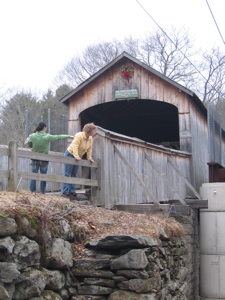
I guess that leaves still one last question… What the heck am I going to write about when I get out to the other covered bridges in Connecticut?
Update! The wonderful book, Connecticut Curiosties by Susan Campbell and Bill Heald solved the mystery of who Comstock was: “Comstock Bridge was named after a formal local postmaster, Franklin G. Comstock.” From the same book, I also learned that, “Town legend says that during prohibition a truck driver crashed on the bridge and tipped over, spilling all the illegal hootch on board. But the locals sprung to action and saved a good portion of the alcohol with buckets.”
Oh, and it was closed to traffic in 1932. Excellent.
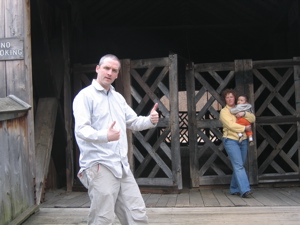
![]()

 lynn says
lynn says
June 17, 2008 at 4:03 amvery entertaining and informative. we’re visiting it today and no longer have a romantasized version of what we’ll be seeing. we’ll go in w/ low expectations and take it from there.
thanks!
 sami says
sami says
November 10, 2008 at 2:31 pmthis does not really help, i looked at this Website for some H/W & i’m sorry but it does not help
i’m in year 11 by the way so bother me
 ron says
ron says
May 3, 2009 at 7:33 amTHEY DO NOT SHOOT PIGS THEY SHOOT CLAY TARGETS AND YOU WIN A HAM.
AS FAR AS THE DEER, I GUESS IT WOULD BE BETTER FOR THEM TO COMPETE WITH EACH OTHER FOR LIMITED FOOD SOURCES. THEN THEY COULD DIE A SLOW COLD DEATH OF STARVATION OR FREEZE TO DEATH.
HUNTING IS THE BEST FORM OF MANAGEMENT TO KEEP THE DEER POPULATION IN SYNC WITH FOOD RESOURCES. AS LONG AS DEER ARE HUNTED IN SEASON AND WITH PROPER TAGS THERE IS NOTHING WRONG WITH IT. ONE DEER WILL FEED A FAMILY OF 4 FOR ALMOST A YEAR,
FOR THE PRICE OF A PERMIT AND TAG
I DO NOT HUNT, BUT I KNOW THE TRUE REASON THAT DEER NEED TO BE KEPT IN CHECK IF THERE WAS NO HUNTING YOU WOULDN’T BE ABLE TO DRIVE YOU CAR TO ALL THESE NICE PLACES WITHOUT HITTING ONE AND
DESTROYING YOUR RIDE OR WORSE
 Steve says
Steve says
May 3, 2009 at 11:05 amSami – I’m sorry I couldn’t help. You’re in “year 11?” Gosh, I should have better addressed your plight then.
Ron – re: the Ham Shoot, I know. I was kidding.
re: Deer hunting… I wrote, “Hunting defenseless deer sounds boring” not “evil” or “cruel” or “unnecessary.” I’m all for culling the deer herd! I just don’t find it a fun thing to do. Heck, I’d want to bring back packs of wolves and bobcats to take care of the deer overpopulation. Of course, that begs the question of how much is “overpopulation” and how much is Humans continuing to build out into their habitat?
Hmm.
 ron says
ron says
May 3, 2009 at 2:28 pmOK COOL WE’RE ON THE SAME PAGE
THE WOLVES WOULD BE SOMETHING SEE
BOBCAT IVE SEEN IN LITCHFIELD
AND YES PEOPLE DO HAVE A TENDENCY TO OVER DO IT AS FAR AS DEVELOPMENT. ALL IN THE NAME OF PROGRESS..RIGHT??
IVE BEEN TO QUITE A FEW OF THE PLACES YOU HAVE COVERED AND SOME I’M CONSIDERING. ITS NICE TO GET A PREVIEW BEFORE DRIVING 45 MIN
ONLY TO BE LET DOWN BY SOMETHING YOU THOUGHT WAS MORE THAN IT REALLY WAS.
THANKS KEEP UP THE GOOD WORK
 Loucindy says
Loucindy says
June 22, 2009 at 11:47 amEast Hampton is the fifth town I’ve lived in since I’ve been in CT and it’s by far the…oddest. And you are right, “there really isn’t a whole heck of a lot to do.”
But, anyway, I actually like the fact that the bridge in closed to traffic. I’ve seen covered bridges before, but this one was the first that I could walk inside and check out. It was kind of fun.
 Don says
Don says
August 24, 2009 at 10:08 amJust to keep the facts straight, the first quoted article is no longer accurate with regard to the statement that the bridge is “still carrying its own weight with the original timber superstructure.”
The large steel beams on either side and underneath now carry a portion, if not all, of the loads. You can see them in the 5th picture. And although they do perform their function well, it’s unforunate that they did not do a better job (or make any attempt whatsoever) at cleverly hiding the strenghening steel members.
It can be done and has been done sucessfully on many covered bridges. Trust me, I’m a Bridge Engineer by trade.
 Steve says
Steve says
August 24, 2009 at 7:16 pmThanks Don… Good to know.
It’s funny how wrong that article clearly is now that I compare it to my picture of the rusted steel beams.
Gosh, I’m the first to tell readers never to trust ME, but when we can’t trust the supposedly smarter people I quote?
Sigh.
 TC says
TC says
February 27, 2010 at 6:57 pmProbably Samuel Comstock of Wilton, CT. Born 1740 and died 12/1/1824. Served in the French & Indian War then swerved thoughout the Revolutionary War in the division of the Commander-in-Chief …. although the family history only shows he was promoted to Major on 10/10/1783. Served at White Plains, Valley Forge, and Yorktown. tcs
 Jake says
Jake says
June 2, 2010 at 9:56 amI’ve grown up next to this bridge my entire life. My dad used to take me there fising as a baby, and I feel like I have a bond with this bridge. Just seeing it brings me back down memory lane. I love this bridge, and when I found out it was renovated, I thought they were going to tear it down. I knew better. Still, I worried. I visit it on a regular basis now.
 cilla says
cilla says
September 15, 2010 at 6:26 amUpdate as of a month ago. This bridge is now under construction, as of Aug 2010. They are using the steel beams to draw the bridge onto land. Taking 30 foot sections down at a time. It will be reconstructed and put back over the river with these beams, and than the steel will be gone. As of Sept 15 2010 only half the bridge is over the river, the other half is in the parking lot.
 Rocky says
Rocky says
February 13, 2011 at 10:50 pmDid you check with anybody to see if this bridge is haunted by any chance?
 Steve says
Steve says
February 13, 2011 at 11:10 pmNo, Rocky, I didn’t. Two reasons:
1. The Bridge actually doesn’t even exist today as they completely dismantled it to rebuild it.
2. There are no such things as ghosts.
Thanks for reading!
 Bub says
Bub says
February 21, 2011 at 10:34 pmMy grandmother used to cross this bridge on her way to school.
Once there were a group of Gypsies camped inside the bridge and she had my great grandfather walk her across. The bridge now used over Rt 16 was built in the 30’s.
 Frank Smith says
Frank Smith says
March 26, 2011 at 10:47 pmI grew up a mile or so away from this bridge. Almost got arrested for driving my dirt bike through it as a kid but took off on the collage aged “warden” who thought he was supercop. I was surprised to see it completely gone last week when I drove by. I’m checking out this site cause I saw something on the tube about a guy from the early part of the last century named Comstock. Thought he might have had something to do with the name of the bridge but guess not. I live in Maine now (thank god) and like to check in on former stomping grounds.
P.S. I shot three deer within a half a mile from the bridge site, one, the biggest buck I’ve shot to date.
FS
 M says
M says
September 28, 2011 at 2:04 pmSo update if your interested. Up until about 2005 or so, the bridge did support its own weight, but state engineers saw that it was dangerously bowing, so quickly added the huge steel supports. After about 5 years, they started dismantling the bridge to repair it/replace any rotted wood, and are now, over the summer of 2011, have started putting back together!
Back in high school, my cross country team frequently met for practice at the bridge. The park (the Salmon River State Forest) actually extends for several hundred acres to the north and south (across Route 16), so its not just the little parking lot next the bridge. Makes an excellent area to explore. On one particularly long run, our team once ended up in the adjacent Day Pond State Forest!
 Scott Hodge says
Scott Hodge says
October 22, 2011 at 2:26 pmI remember growing up in East Hampton back in the 60’s and 70’s fishing off of this bridge and going to trout derbies with my Grandfather. Those times were very special to me. I am so glad that my home state has preserved this bridge and I hope this bridge will can be preserved long into the future.
 Eric says
Eric says
October 16, 2012 at 3:26 pmI meant to post this a while back…but it slipped my mind. For those interested in visiting the bridge, who might be concerned that the bridge is still undergoing renovation, I have it on good authority that the bridge is back up. I don’t remember exactly when, but a while back (Spring 2012?) a friend of mine posted some pics to facebook.
 Tom Aparo says
Tom Aparo says
April 21, 2015 at 6:42 pmI am not so sure that it is not named after General Comstock. He was brevetted in 1866 as a major general of volunteers and a Brigadier in the regular army. He was a highly skilled engineer whose most important works were almost certainly the pontoon bridges he built in the aftermath of Chancellorsville. From 1867 – 1895 he was in command of the US Army Corps of Engineers. They are famous for their bridges and damns. The Bridge was actually built in it’s present form in 1873 so the timeline fits nicely. Bridges are often named after their designer. I think a little more research might be in order before I can say who the bridge is named after, but I think that the one who designed and built bridges and shares the name should be strongly considered.
 Steve says
Steve says
April 22, 2015 at 7:48 amTom – If you’d like to be my volunteer unpaid fact-checker, i’ll be more than happy to bring you on! Thanks!
 Hal says
Hal says
June 30, 2016 at 7:05 pmI lived in both East Hampton and Colchester and visited the park often. The real park is right across the street and very nice. It has been a favorite spot of many for a long time. The deer around here were plentiful when my father in law and his brother owned at the top of Bull Hill apple orchards. The hunter could get a form bring it to them and gain permission to hunt at the orchards. The deer were for meals that were hunted. Those years have passed and the orchards are now beautiful homes. I did not read all the replies so I do not know if it was mentioned that their was that went through there way back, too.